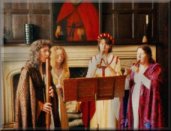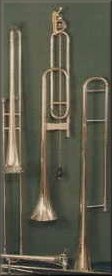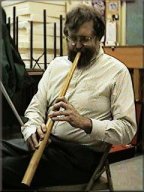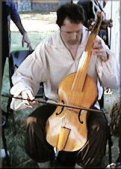

| Until the end of the 16th Century, musical instruments
had been mainly used to accompany voices. But just before 1600, in Italy
in particular, composers began to write pieces for instruments alone. The
Sonata
came to have a special meaning later on in musical history, but at this
time it simply meant a piece to be played on instruments as opposed to
being sung (Cantata).
Gabrieli wrote Sonata Pian' e Forte for two contrasting groups of instruments. In each group, the three lower instruments are Sackbuts (the predecessor to the modern trombone). In the first group, the top part is written for the Cornett whilst the second group's top part is marked for Violino (a small viol - an instrument similar to the modern viola). |

A Consort of Players |
|
|
|
||
| Many names have been given to the
Renaissance trombone, including sackbut (literally "push-pull"), saqueboute,
shakbusshes, seykebuds, sakbuds, shakebuttes, shagbutts, and even shagbolts!
It is uncertain when the sackbut first appeared, but by 1500 it is illustrated and mentioned regularly. Detailed information about the instrument is given by Praetorius, who also pictures four principal sizes: the alto, tenor, bass, and great bass. The tenor sackbut is the most useful size and it is this instrument which has evolved into the modern tenor trombone. In the early seventeenth century the sackbut was considered an instrument of the virtuoso performer.
|

A Collection of Sackbuts |
|
|
|
||
| The cornett was a straight, tapered, one-piece instrument that was turned on a lathe. Instead of having a detachable mouthpiece, a tiny conical recess was cut into the top to serve as the mouthpiece. There are holes in the body for fingering similar to recorders. The narrow bore of the mute cornett gave it an exquisitely soft sound and made it ideal in consorts with recorders, lutes, and viols. |

A Cornett |
|
|
|
||
| The viols were bowed instruments with frets.
They were usually played held downwards on the lap or between the legs
(the name viola da gamba translates to leg viol). The tone is quiet but
with a rather distinctly nasal quality which many think makes it too restrained
for dance music but an ideal instrument for polyphony where the clarity
of texture is so important. The viol played on the lap was known in Europe
as early as the 11th century, and is pictured in the art of the time. After
the 13th century this style of playing bowed instruments had almost completely
disappeared, only to re-emerge two centuries later as the popular Renaissance
viol. The viols were used so much by court musicians throughout Europe,
that it was explained that the viol was played by genlemen, merchants and
other men of virture, while the violin was played in the streets to accompany
dances or to lead wedding processions.
The instrument was introduced to the English court of Henry VIII by Italian and Flemish players and soon became popular with amateurs as well as court musicians. Like madrigal singing, viol playing had become part of music-making in the Elizabethan home by the end of the 16th century. Viols were popular in England long after they had been replaced by the violin on the Continent. |

Viola da Gamba |
|